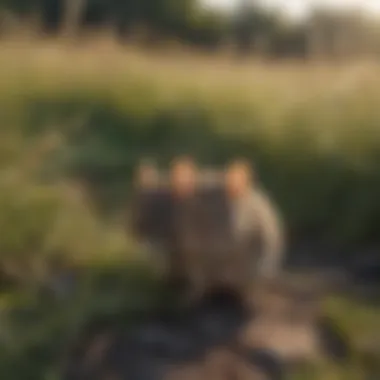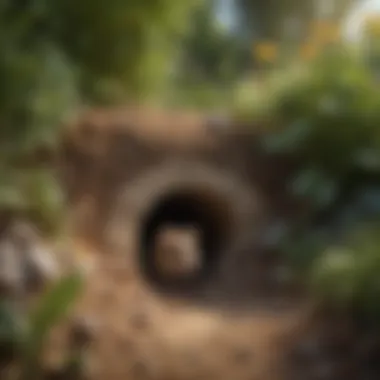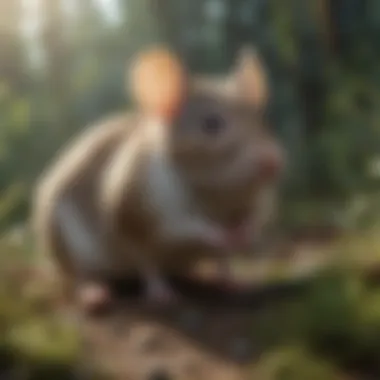Exploring the Outdoor Habitats of Mice


Intro
Mice, those small critters often seen as nuisances, play fascinating roles in our ecosystems. Understanding their living conditions can provide homeowners and gardeners with critical insights into how to manage interactions with these animals effectively. The habitats where outdoor mice thrive showcase their adaptability, a feature that often surprises many. By illuminating their habitats, nesting behaviors, and ecological roles, this discussion is aimed at equipping readers with knowledge that is not just informative, but practical.
Delving into why mice choose specific locations, their interactions with the environment, and their impact on local ecology is key. Mice are not mere pests; they are integral to the balance within ecosystems. This understanding can pave the way for implementing preventive measures and control solutions that respect both nature and our living spaces.
Let's begin with a closer look at what constitutes a pest in our world, starting with an understanding of outdoor mice.
Understanding Pests
Definition of Pests
The term "pest" refers to any organism that is perceived as harmful or a nuisance to humans, agriculture, or the environment. In the case of outdoor mice, they are typically categorized as pests primarily because of their propensity to seek shelter in human structures, nibbling on food supplies, and causing damage in the process. Despite their reputation, it's essential to recognize that these small mammals have their place in the ecosystem, aiding in seed dispersal and serving as prey for various predators.
Importance of Pest Identification
Identifying outdoor mice accurately is crucial for effective management. Knowledge about their specific habits and habitats allows homeowners to distinguish between different types of rodents that may invade their spaces. For instance, house mice are often found in buildings, while field mice prefer grassy areas and gardens. Differentiating between these can guide decisions about management strategies that are appropriate and humane.
"Understanding mice habitats helps homeowners take informed actions without resorting to unnecessary harm."
By grasping the underlying issues that attract mice, such as food sources or shelter, better preventive strategies can be established.
Prevention Techniques
Home and Garden Preventative Measures
Taking steps to make homes and gardens less inviting to mice is an effective management approach. Here are several strategies:
- Seal Entry Points: Mice can squeeze through surprisingly small gaps. Sealing holes around pipes and vents can greatly reduce their access.
- Store Food Properly: Keeping food in tight containers and ensuring that pantry areas are free from crumbs can deter mice from scuttling in.
- Utilize Landscaping Wisely: Maintain outdoor areas by keeping vegetation trimmed. Dense bushes and tall grass offer hiding spots for mice.
Seasonal Prevention Tips
Different times of the year can bring unique challenges in managing outdoor mice:
- Fall: As temperatures drop, mice look for warmth. Check areas near doors and windows for drafts.
- Winter: During colder months, it’s crucial to monitor attics and basements for signs of activity.
- Spring: As the weather warms, mice may be more active while nesting. Regular inspections around exterior walls can catch them before they settle too deep into habitats.
Eco-Friendly Pest Control Solutions
Overview of Sustainable Practices
When it comes to managing mouse populations, eco-friendly and ethical practices are becoming more popular. Tactics that are safe for both the environment and the inhabitants of our homes can be quite effective.
- Companion Planting: Certain plants naturally repel mice. For example, planting mint can deter their presence in gardens.
- Trapping: Using humane traps can help catch mice without causing them harm. After capture, it’s always best to release them far from home to prevent return.
Natural Remedies and Their Effectiveness
Utilizing natural substances can offer another layer of defense against unwanted mouse visitors:
- Peppermint Oil: Many claim that a few drops of peppermint oil on cotton balls, placed in strategic locations, can deter mice from entering.
- Ultrasonic Repellents: These devices emit sounds at frequencies that disturb rodents. Some find these effective and non-intrusive.
Understanding mice is more than just managing an infestation. It’s about balancing our environments while respecting the roles these small mammals play. By being informed and proactive, mouse populations can be managed in ways that consider the ecology around us.
Understanding Mice Habitats
Understanding the habitats of outdoor mice is crucial for various reasons. First off, it helps us appreciate the intricacies of ecosystems. Knowing where these little creatures thrive can shed light on their roles within food chains and their interaction with other species. Moreover, with growing urbanization, understanding their behavior and living conditions can assist homeowners in managing populations effectively.
Mice occupy various habitats, adapting to both natural environments and urban settings. Being aware of their preferences can influence how we design our gardens and manage waste. In doing so, we create a coexistence that respects wildlife while ensuring our spaces remain pleasant.
Importance of Mice in Ecosystems
Mice are more than just pesky rodents. They play a pivotal role in ecosystems, acting as both prey and scavengers. Their presence influences plant growth and soil aeration, which are critical for a healthy environment.
Role in Food Chains
The role of mice in food chains is significant, particularly as a food source for many predators. They serve as a bridge between various trophic levels, helping to transfer energy from plants up to higher-order predators like snakes and hawks. One key characteristic of mice is their prolific breeding habits, which ensures they remain a stable food source. When understood correctly, this aspect can lead to an appreciation of their ecological value rather than viewing them merely as nuisances.


However, while they contribute positively to that food web, having an overpopulation of mice may create an imbalance, leading to increased predation pressure on their food source.
Interaction with Other Species
Mice don't live in a vacuum; their interactions with other species can have profound implications. They are not just food but also contribute to seed dispersal, aiding in plant reproduction. The remarkable adaptability of mice to coexist with other wildlife makes them a common sight in diverse environments.
Their relationships with local fauna highlight the interconnectedness of ecosystems. For example, when mice scurry about, they inadvertently stir up soil, making nutrients available for other organisms. But it’s worth noting that their interactions can sometimes lead to problems, particularly when they venture into urban areas where they might compete with other wildlife for resources.
Types of Outdoor Environments
Mice are found in various outdoor environments ranging from vast forests to busy urban areas. Knowing where they thrive helps anyone trying to manage their presence.
Natural Landscapes
In natural landscapes such as forests and grasslands, mice find abundance in resources like food and nesting material. A defining feature of these habitats is the variety of niches available, allowing them to thrive in bushes, undergrowth, or even underground. This diversity offers safety from predators while providing ample food sources, like seeds, nuts, and insects.
Natural landscapes are crucial for the ecological balance, supporting not only mice but countless other species. However, habitat destruction can have negative repercussions; loss of such environments can endanger mice populations and disrupt existing ecological dynamics.
Urban Areas
Urban areas present a different set of challenges and opportunities for mice. Here, they often find themselves in close proximity to humans, allowing them to exploit food waste and shelter in buildings. One unique feature of urban settings is the abundance of food sources, often found in garbage bins or as leftovers from gardens.
While urban environments can be beneficial for some populations of mice, they also expose these animals to various risks, such as predators like cats or danger from vehicles. In this way, urban habitats can be a double-edged sword, providing food but also posing threats they might not face in more natural settings.
Natural Habitats of Mice
Understanding the natural habitats of mice is crucial for various reasons. Mice, as small mammals, play a significant role in ecosystems, serving as both prey and pest. Their habitats impact their behaviors, interactions, and the overall ecological balance. Recognizing where mice thrive can illuminate our engagement with them, whether for purposes of conservation, pest control, or simply enhancing our appreciation for wildlife.
The environments they choose are influenced by multiple factors, including availability of food, nesting sites, and protection from predators. Knowing these considerations can help homeowners, gardeners, and wildlife enthusiasts create a harmonious coexistence with these creatures, rather than a confrontational one.
Forests and Woodlands
Nesting Preferences
Mice in forests often have specific nesting preferences that align with their natural instincts. Typically, they look for dense underbrush, tree roots, or old logs as prime nesting sites. This choice is beneficial because it offers protection from predators and severe weather conditions.
A unique aspect of nesting in woodlands is the abundant cover provided by foliage. This not only keeps them hidden but also helps maintain their body temperature, especially in colder seasons. However, it does have its downsides; these locations may also be prone to flooding or disturbance from larger animals, impacting the stability of their habitats.
Food Sources
In terms of food sources, forests offer a cornucopia of options: seeds, fruits, and even insects. The diversity of food available is a significant reason mice prefer these habitats. For example, acorns from oak trees or berries in bramble bushes are common dietary staples.
Mice can be quite opportunistic feeders, which is a characteristic that serves them well in woodlands. They often stash food nearby, allowing them to survive in leaner times. However, the challenge here is competition with other foragers; the abundance might attract other species, potentially leading to food scarcity during peak population times.
Grasslands and Fields
Burrowing Behavior
Grasslands provide a different landscape where mice have adapted unique burrowing behaviors. Their burrows serve as homes and are crucial for shelter and safety. The depths of these burrows can vary, often depending on the soil type and moisture.
These burrowing strategies not only protect them from predators but also create a microclimate that can help regulate temperature. Yet, one potential drawback is the vulnerability of these burrows to erosion and flooding, which can wipe out entire colonies.
Predation Risks
Speaking of predators, grasslands come with their own set of risks. Mice are preyed upon by foxes, hawks, and snakes, making them constantly vigilant. The open spaces lack the cover offered by woodlands, which can make it harder for mice to find security from these threats.
The critical characteristic of predation risk in grasslands is the visibility challenges it presents for mice. They must be adept at quickly locating shelter when they sense danger. While this constant threat drives some adaptive behaviors, it also limits their feeding opportunities as they have to balance foraging with safety.
Marshes and Wetlands
Water Sources
Marshes present a unique aspect of mouse habitation, particularly concerning water sources. Here, mice have adapted to semi-aquatic environments, relying on abundant fresh water. This is especially crucial for hydration and breeding purposes.
A notable benefit of living in marshy areas is the rich diversity of food sources, like small plants and insects. However, too much water can pose risks, such as flooding their nests, which can be detrimental to young mice. Managing these delicate ecosystems is essential for sustaining their populations.


Vegetation Types
The vegetation in marshes and wetlands plays a pivotal role in how mice survive in these habitats. Dense reeds, grasses, and shrubs provide ample cover and hiding spots. This variety offers not only shelter but also a diverse diet.
However, the reliance on specific vegetation types means that environmental changes can seriously impact mice populations. If the vegetation dies back due to pollution or climate change, it can lead to significant food shortages and habitat loss for mice in these areas.
Ultimately, understanding these natural habitats helps us appreciate the intricate balance in ecosystems and encourages responsible coexistence, particularly for homeowners and nature lovers alike.
By comprehending the various elements related to natural habitats, we uncover important insights into mouse behavior and how they interact with the environment. This knowledge can guide practical steps for managing mouse populations effectively, enhancing the living conditions within their habitats.
Adaptations of Mice to Urban Areas
As urban environments expand and evolve, so too do the mice that inhabit them. Understanding how these small mammals adapt to urban life is crucial, not just from a biological perspective, but also for anyone looking to manage their populations effectively. Mice have a remarkable ability to thrive in human-modified landscapes, which brings forth both benefits and challenges for homeowners and pest control enthusiasts alike.
Nesting in Residential Zones
Common Nesting Sites
Mice are quite resourceful when it comes to finding nesting spots in urban areas. They often take advantage of attics, basements, and even the nooks and crannies of garden sheds. These locations offer protection from predators and harsh weather, making them appealing to mice. One of the key characteristics of these common nesting sites is their accessibility; they are often hidden away from human sight, allowing mice to reside in relative peace.
- Advantages:
- Secluded environments protect them from predators.
- Access to warmth and shelter from the elements.
However, this behavior can lead to problems for homeowners. With nests being located in residential zones, the potential for mouse infestations increases, which can disrupt peace and cause damage to the property.
Human Structures Exploited
Mice have honed their skills in finding refuge within man-made structures. They are especially drawn to buildings with pre-existing cracks and crevices. Warehouses, restaurants, and even individual homes often provide convenient shelter. The key characteristic of these exploited structures is their adaptability; mice can quickly learn to navigate the human environment to find safe havens.
- Advantages:
- Easy access to shelter and heat in colder months.
- Proximity to food sources like garbage and pantry items.
On the downside, this often leads to increased risk of damage within homes, as mice can chew through electrical wiring or insulation, causing potential hazards.
Feeding Habits in Urban Environments
Urban mice have become experts at securing their sustenance, utilizing the bounty left behind by humans. Their feeding habits are diverse, promoting survival in a variety of settings.
Food Accessibility
The urban setting offers a smorgasbord of food options for mice. From discarded trash to pantry staples, these creatures have adapted to locate food easily. A key element of food accessibility is its abundance, which has made urban areas particularly attractive for mice as they can forage with minimal effort.
- Advantages:
- Easy access to a wide variety of food sources.
- Opportunities for scavenging during late-night hours when human activity is low.
However, this reliance on human food sources can lead to health risks for mice, particularly when consuming processed or spoiled foods.
Scavenging Behaviors
Scavenging is a critical feeding behavior for mice living in the city. They exhibit remarkable resourcefulness, rummaging through refuse to find edible materials. This behavior is one aspect of their adaptability, allowing them to thrive even in dense populations. The key feature of scavenging behaviors is the ability to exploit what is often overlooked or discarded by humans.
- Advantages:
- Efficient use of available resources increases survival chances.
- Flexibility in diet means they can adapt based on what is available.
That said, scavenging can also expose mice to dangers such as traps or poisons set out by homeowners, which leads to increased mortality rates in urban populations.
It's essential to note that while some might see mice as mere pests, their adaptability in urban settings teaches valuable lessons about resilience and the complex interplay between species and environment. Understanding this can help develop more effective management strategies.
Environmental Influences on Mouse Habitation
Understanding the environmental influences on mouse habitation is crucial for grasping how these small rodents adapt to different conditions. Outdoor mice exhibit remarkable versatility, adjusting their living conditions based on seasonal shifts and human activities. Content on this section presents an analysis of how these factors not only shape their habitats but also interact with their behaviors, survival strategies, and population dynamics.


Seasonal Changes
Seasonal changes significantly affect the living conditions and overall behavior of outdoor mice. These variations, driven by temperature and availability of food, compel mice to alter their habits in response to what's on the menu, so to speak.
Behavioral Adjustments
Behavioral adjustments refer to the adaptations that mice exhibit due to the changing seasons. For instance, as winter rolls around, many species tend to seek warmth and security. This change in behavior often leads them to build nests in more sheltered locations, sometimes within the walls of a home or under decaying leaves in outdoor environments.
The key characteristic of these adjustments is their focus on survival—finding cozy nests protects them from predators and harsh weather. This kind of shift is beneficial for mice as it increases their chances of survival during colder months. On the downside, this behavior can often bring them closer to human dwellings, leading to potential conflicts.
In warmer months, however, mice are more active and tend to forage more openly. Their food-seeking behavior becomes less cautious, but this openness also exposes them to increased predatory risks. Therefore, while these seasonal behavioral adjustments help them survive, they also keep them on their toes when it comes to safety.
Migration Patterns
Migration patterns play a significant role in how mice inhabit various areas. Many mice are instinctively nomadic, venturing farther from their birthplaces when food becomes scarce or if the environment shifts abruptly.
A key feature of these migration patterns is their seasonal timing; typically, as winter closes in, mice may migrate toward dens or areas with better food supplies and cover from the elements. This migration is a popular choice for outdoor mice due to the survival advantage afforded by relocating to warmer or resource-rich areas. However, moving too far from their primary habitat could expose them to new predators or unfamiliar environments that may not be as hospitable.
An interesting aspect of migration is that it allows for genetic mixing among mouse populations, which can enhance genetic diversity. However, it can also lead to territorial disputes as different populations intermingle, thus bringing potential stress to the newly settled mice.
Human Impact on Mouse Habits
Humans have an undeniable impact on the habitats of outdoor mice. From urban development altering landscapes to pollution causing habitat disruption, these factors are pivotal in how mice live and survive in various environments.
Urban Development Effects
Urban development effects refer to the ways in which construction and expansion of cities can impact mouse populations. As humans continue to build homes, shopping centers, and roads, these alterations reconfigure the natural habitats where mice thrive. The key characteristic here lies in the fact that, while urban areas may provide ample food sources, they also create challenges in terms of hiding places and safe nesting. Thus, mice often have to adapt their behaviors, becoming more cunning and resourceful, often exploiting human discard.
Despite the downsides of urban development, it can lead to an increase in mouse populations due to the abundance of food waste in city settings. This growth can, however, lead to pest control issues for homeowners—a cyclical problem that often leads to more aggressive management strategies.
Pollution and Habitat Disruption
Pollution and habitat disruption encompass the adverse effects of contaminants and human activities on the environments where mice live. This aspect is critical because pollution can deteriorate the quality of the air, soil, and water, directly affecting food sources. The primary concern is that polluted areas may force mice to relocate or adapt their foraging behavior, causing potential nutritional deficiencies.
A defining feature of this disruption is its harsh impact on ecosystems. Continuous pollution can wipe out local flora and fauna, further pushing mice into less suitable habitats. These shifts can have long-lasting consequences, not just for mice but for entire ecosystems dependent on their existence and roles.
In summary, understanding the environmental influences on mouse habitation equips us with deeper insights into their behaviors and the challenges they face, especially in a rapidly changing world. By observing these influences closely, we can manage mouse populations more effectively, fostering a balance that respects the coexistence of human and wildlife.
Managing Mouse Populations Outdoors
Managing mouse populations outdoors is a vital component of ecological balance and a significant concern for homeowners and gardeners. The presence of mice can have both positive and negative influences on the local ecosystem. While mice play their role in the food chain, their increasing number can lead to property damage and health risks. Understanding the methods to control their populations not only protects your home but also supports the environment by enabling a healthier and more controlled habitat.
Effective management begins with understanding the basics of mouse behavior and habitat preferences. Proper implementation of preventative measures can significantly reduce the likelihood of encounters between humans and mice. First and foremost, prevention is much easier and more cost-effective than dealing with an infestation later.
Preventive Measures for Homeowners
Creating Physical Barriers
Creating physical barriers is one of the most direct and effective ways to control mouse populations. By identifying and sealing potential entry points into your home, you greatly reduce the chances of mice making themselves comfortable as unwelcome guests.
A key characteristic of this method is its simplicity. Homeowners should focus on areas such as gaps around doors and windows, cracks in walls, and holes in foundations. The materials used can range from steel wool, which deters mice effectively, to various types of sealants. This choice is beneficial because it’s non-toxic and doesn’t rely on chemicals. However, a unique feature to consider is the need for regular maintenance. Over time, barriers can degrade, so keeping an eye on them is crucial. The advantage here is clear: it's a proactive approach to mouse management.
Food Storage Practices
Food storage practices play an equally vital role in managing mouse populations outdoors. Keeping food securely stored not only benefits your household but also reduces the temptation for mice to linger.
Proper storage means using airtight containers made from durable materials, ensuring no scent leaks to lure mice close to your property. A major benefit of this practice is that it’s simple and only requires an initial investment in quality food storage solutions. The unique feature of these containers is that they additionally prevent other pests, such as insects, from contaminating food supplies. However, one downside is the potential cost of investing in multiple containers for various food items.
Eco-friendly Pest Control Techniques
Natural Deterrents
Natural deterrents are gaining traction as a preferred choice for eco-conscious individuals. It’s evident that many homeowners are starting to look for methods that don’t involve harsh chemicals. Using scents that are unappealing to mice, such as peppermint oil or vinegar, can effectively create a barrier without harming the environment.
One of the key characteristics that make natural deterrents appealing is their safety for families and pets. This factor is particularly beneficial for households with young children. A notable advantage of these methods is their sustainability; they pose minimal harm to the ecosystem. Nevertheless, a disadvantage can be their variable effectiveness, as some homeowners might find these natural solutions require constant reapplication to keep mice at bay.
Habitat Modification
Habitat modification encompasses all actions taken by homeowners to change their outdoor environments to discourage mouse habitation. This practice can include cutting back shrubs, keeping grass short, and removing debris that may serve as nesting grounds.
This approach is beneficial as it not only disrupts potential habitats for mice but also enhances the overall aesthetic of the property. One unique feature of habitat modification is that it often leads to an improved landscape, which presents added value for homeowners. However, a challenge lies in the diligence required, as neglecting maintenance can allow mice to quickly reclaim favorable habitats.
By employing these methods, homeowners can create an environment less hospitable to mice while setting up boundaries that protect their living spaces.



